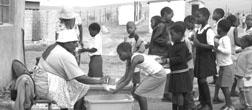Through loveLife, a national South African survey of 12,000 15-24 year olds accumulated data to:
1) Establish the prevalence of HIV and related behaviors among young people
2) Assess young people’s sexual attitudes
3) Examine the extent of young people’s exposure to loveLife.
Below is my summary of the summary provided in the loveLife study:
(Note Click on Tables for bigger images)
Profile of HIV Positive Youth
Among HIV positive 15-24 year olds (roughly 10% of all young South Africans in this age group), 77% were female. Seventy-five percent of HIV positive individuals were age 20-24 years and 95% were African. By location, 59% of HIV positive youth live in urban areas (urban formal and informal) and 41% live in rural areas (rural informal and farms). Among those age 20-24, HIV positive youth were significantly less likely to have completed high school compared to HIV negative youth (23% vs. 41%). HIV positive youth were also significantly more likely to report being unemployed compared to their HIV negative counterparts (56% vs. 29%).
Although young people reported HIV/AIDS to be the biggest problem facing young people in South Africa and in their communities and although 45% of young people say they personally know someone who has died of AIDS, the vast majority of youth do not think they personally are at risk for contracting HIV. In fact, 61% of HIV positive and 73% of HIV negative youth reported that they thought they were at no risk at all or had a small chance of getting HIV.

Young women are disproportionately affected by HIV
Women have roughly 3 times the prevalence of HIV compared to their male counterparts; nearly 1 in 4 women age 20-24 years in South Africa is infected with HIV compared to roughly 1 in 14 males of the same age. Among the 10% of South African youth who are HIV positive, 77% are women.
Gender power imbalances exist in sexual relationships
Noting the higher rates of HIV amongst young women than men, it is important to try to ascertain whether coercion plays any role in their sexual decision-making. Women's sexual partners were on average 5 years older, increasing gender power differentials, which make it more difficult for women to refuse unwanted sex or negotiate condom use. Forty-three percent of all women agreed that is harder to refuse sex with a sexual partner who is older compared to someone the same age. Further, twenty-nine percent of sexually experienced women reported that there were times when they had sex with their partner even though they did not want to because he insisted. Sexually experienced males and females also characterize their first sexual experiences very differently with close to 30% of females reporting that they did not want to have sex their first time compared to only 1% of males.

Young African youth are disproportionately affected by HIV
African youth have the highest HIV prevalence of all races. Ninety-five percent of all young people affected by HIV are of African race. African youth were more likely to report ever having sex than the other race groups and are more likely to report having sex at age 14 or younger than other races, but they were as likely to report using condoms at last sex as other races and did not report having more sexual partners than other race groups.

Young people are talking about HIV/AIDS
Forty-four percent of youth reported having talked to their parents about HIV/AIDS and of those youth that had spoken to their parents, the vast majority reported that they found the conversation helpful. Even more youth, 80%, say they have spoken to someone other than their parents about HIV/AIDS. While youth are talking, most youth are talking to their friends about HIV/AIDS and far fewer report talking to their sexual partners, the group of people with whom it is perhaps most important that they do discuss HIV/AIDS.










No comments:
Post a Comment